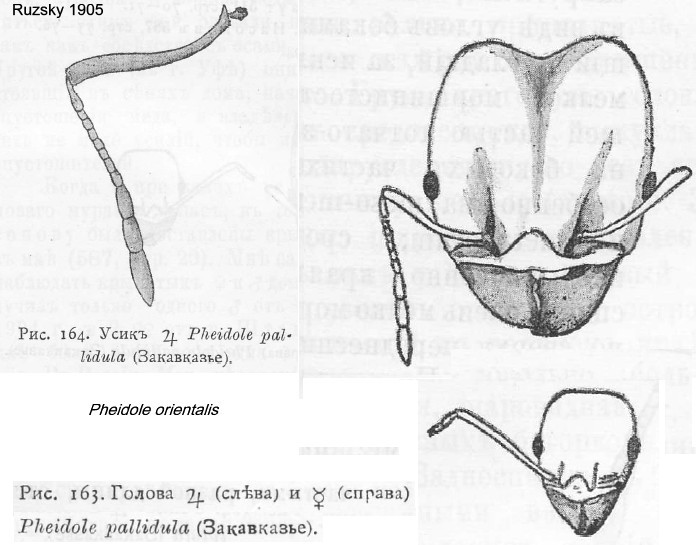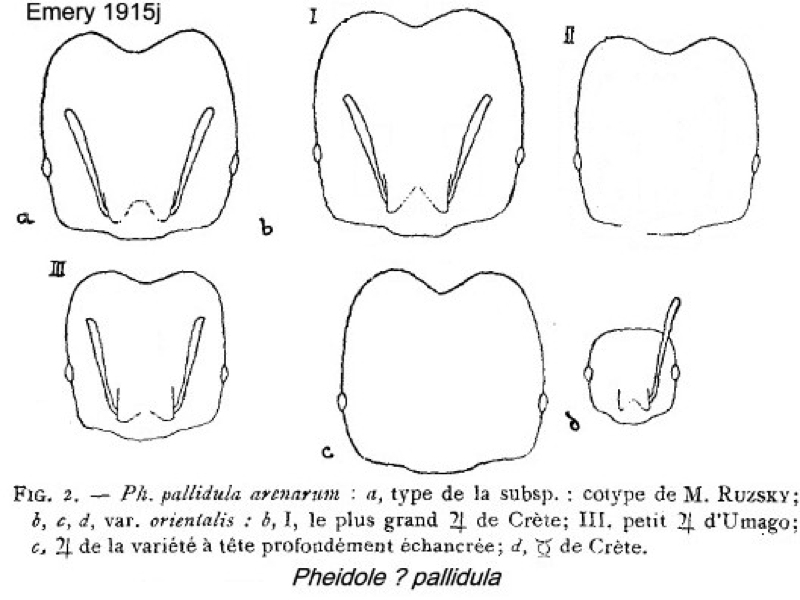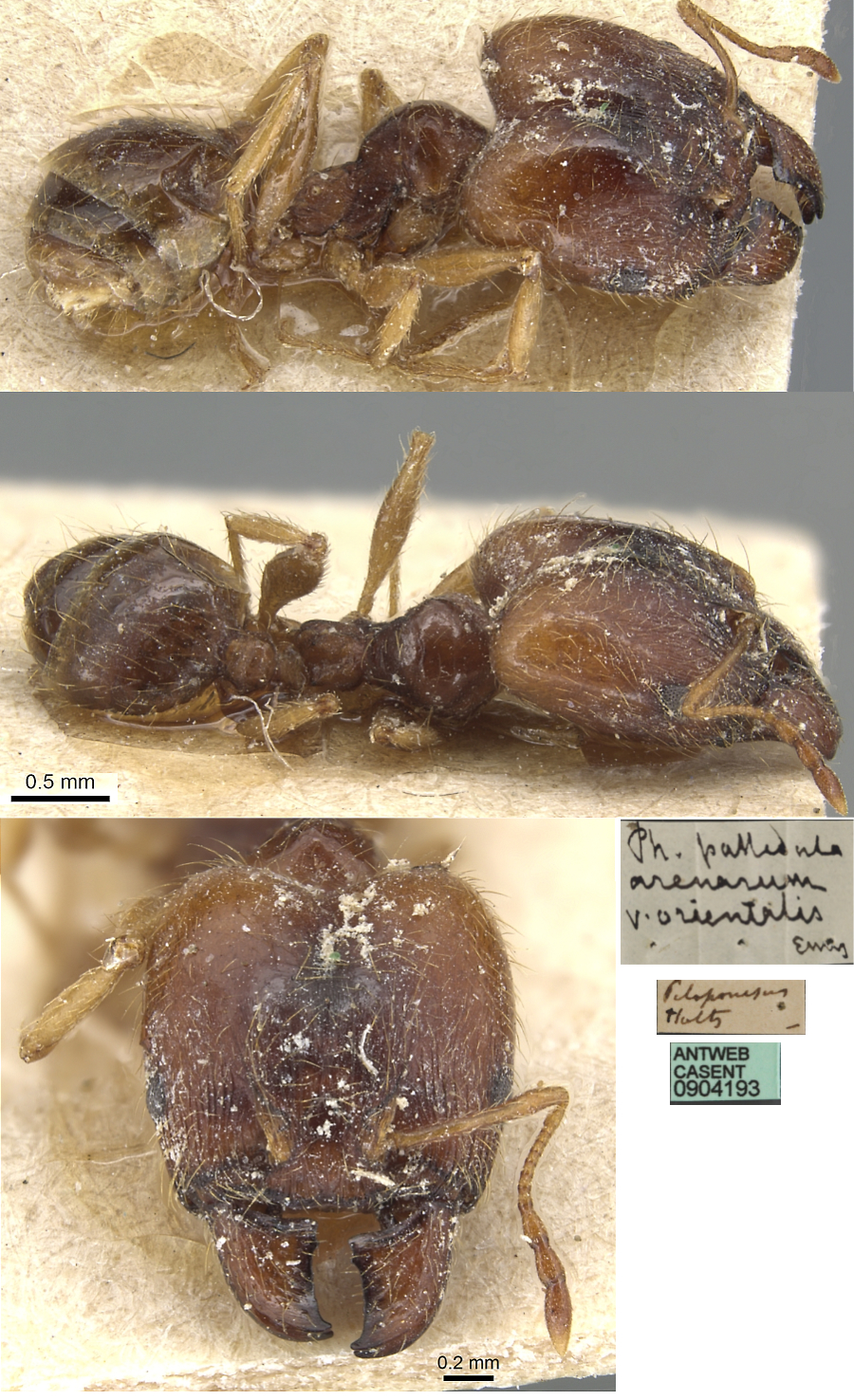Pheidole orientalis Müller - new status
 MAJOR MAJOR  MINOR Type location "the
Orient" (Pheidole pallidula Nyl., subsp. arenarum
Ruzsky
var. orientalis n., Emery, 1915j: 230, the pallidula of
Ruzsky, 1905: 643, illustrated, all forms; Pheidole pallidula orientalis
(Emery), emend., Müller, 1923: 69, soldier
& worker).
MINOR Type location "the
Orient" (Pheidole pallidula Nyl., subsp. arenarum
Ruzsky
var. orientalis n., Emery, 1915j: 230, the pallidula of
Ruzsky, 1905: 643, illustrated, all forms; Pheidole pallidula orientalis
(Emery), emend., Müller, 1923: 69, soldier
& worker).
Separated here from Pheidole pallidula and Pheidole arenarum
|
 Ruszky's
(1905)
description orientalis (as pallidula)
& arenarum is at Ruszky's
(1905)
description orientalis (as pallidula)
& arenarum is at  . Emery (1915j) gave an illustrated note on
orientalis & arenarum, this is at . Emery (1915j) gave an illustrated note on
orientalis & arenarum, this is at  . .
Mayr (1880: 38) wrote in his note on "Pheidole pusilla"
how he regarded P. pallidula as known from southern Europe and
Algeria, whereas P. pusilla was cosmopolitan into the south
European peninsulas, with soldiers that had long propodeal spines being
P. pusilla; the note is at  . .
|
 Emery
(1915j: 229) emphasised that the type form was not found in Asia, and
Ruszky was wrong, what Ruszky described as pallidula was an
undescribed form. Emery called that orientalis and regarded it
as very close to the Ruszky subspecies arenarum. He noted also
the identity of "Pheidole pusilla" of Mayr (1877, 1880,
Fedtschenko voyage to Turkestan) and megacephalo-pallidula of
Emery & Forel (1979) were probably of this eastern form. Emery had
not seen those reported from Egypt or from the Balkans. Emery
(1915j: 229) emphasised that the type form was not found in Asia, and
Ruszky was wrong, what Ruszky described as pallidula was an
undescribed form. Emery called that orientalis and regarded it
as very close to the Ruszky subspecies arenarum. He noted also
the identity of "Pheidole pusilla" of Mayr (1877, 1880,
Fedtschenko voyage to Turkestan) and megacephalo-pallidula of
Emery & Forel (1979) were probably of this eastern form. Emery had
not seen those reported from Egypt or from the Balkans.
Emery (1915j) noted the minor of arenarum and
its variety orientalis had the head widely truncate
posteriorly, with more rounded posterior angles; the scape surpassed
the occipital border by one-third of its own length, e.g. much more
than in the type form minor. The pedicel was like the type but
sometimes the propodeal spines were longer. Dark brown or chestnut
brown; the major head was lighter, brownish yellow-red. On orientalis
he drew attention to the sides of the head being more cuvred than in arenarum,
Specimens from the "Orient" were all or the "plus claire" paler orientalis
variety. He reported specimens sent to him from the
Adriatic are by Dr K Wolf, where the paler type form was found in the
northern Trieste area but specimens from the southern Umago and Rovigno
were all of the dark orientalis variety
|
 The
photomontage of a major worker, from among those listed by Emery
(1915j), is collated from http://www.antweb.org/specimen.do?name=casent0904193. The
photomontage of a major worker, from among those listed by Emery
(1915j), is collated from http://www.antweb.org/specimen.do?name=casent0904193.
|
With the availability of fresh specimens
from Israel and Saudi Arabia, the link pages give fresh photographs and
descriptions of
Major
workers; Minor
workers
|
Oxford University Museum
specimens
Pheidole orientalis
B Taylor det.
|
Israel
A Ionescu
|
23.iii.2007
Shoham
30°39' N
34°26' E
|
hand collected
majors & minors
|
8
|
 |
Pheidole orientalis
B Taylor det.
|
Saudi Arabia
M Sharaf
|
1.iv.2004
Abha
18°12'59" N
42°30'19" E
|
Wadi Abha
majors & minors
|
4
|
 |
Pheidole orientalis
B Taylor det.
|
Saudi Arabia
M Sharaf
|
10.i.2008
Abha
18°18' N
42°44' E
|
Abha Khamis Road
majors & minors
|
2
|
 |
Pheidole orientalis
B Taylor det.
|
Saudi Arabia
M Sharaf
|
15.iv.2008
Dalaghan-Asir
18°05' N
42°43' E
|
major
|
1
|
 |
Pheidole orientalis
B Taylor det. |
Iran
S Moradloo
12
|
2.v.2013
36.61°N
48.28°E
|
Gholi Kandi
1911 m 27°C
Forest, on trees
Major worker, body and head separate
|
1
|
 |
Pheidole orientalis
B Taylor det. |
Iran
S Moradloo
13
|
2.v.2013
36.61°N
48.28°E
|
Gholi Kandi
1911 m 27°C
Forest, on trees
Major & minor workers
|
7
|
 |
|
|